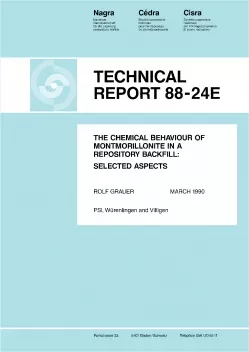
Technical Report NTB 88-24
The chemical behaviour of montmorrillonite in a repository backfillSelected aspects
With a view to supplementing an earlier report (NTB 86-12, EIR Report no. 576), publications appearing in the interim period have been evaluated. Particular emphasis was placed on the thermodynamic status of the clay minerals, the long term stability of montmorillonite and interactions with other repository components.
Smectites and illites are presumably thermodynamically unstable and even the formation of metastable solubility equilibria is questionable. Basic problems are thus encountered when formulating equilibrium models for the clay/water interaction.
It can be concluded from investigations of argillaceous sediments that, given a repository temperature of 50 to 60°C, a maximum of 50 % of the montmorillonite will alter to illite over a period of around 108 years. The formation of such illite/smectite interstratifications does not impair the function of the backfill material. Since the alteration of calcium montmorillonite is very restricted in comparison with that of the sodium variant, a calcium bentonite should be foreseen as the backfill material.
Magnetite is probably unstable in the presence of montmorillonite. The thermodynamic data and experimental results necessary to allow a reliable assessment of potential interactions between the bentonite and the steel canister corrosions products are lacking. Given the current state of knowledge, the formation of iron-rich microcrystalline layer silicates is to be expected.
Montmorillonite in contact with alkaline cement pore waters reacts to form zeolites. This alteration is linked with a volume increase and a loss of plasticity.
